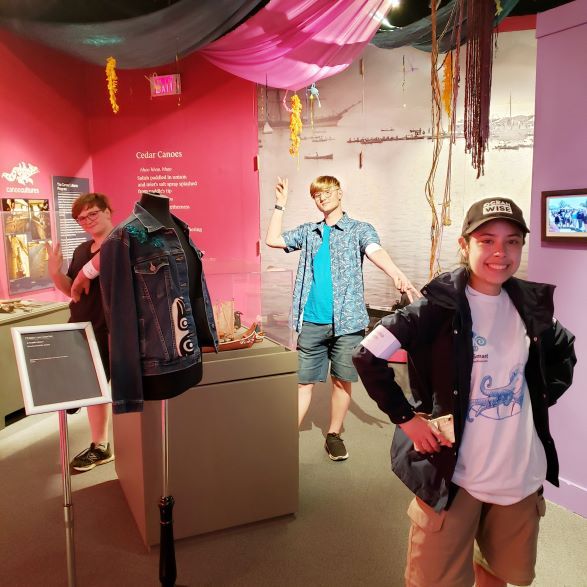Climate Change and Health Active Game

Project Details
Project dates

Project Lead
In YouthToSea, I created conceptualized and designed an active, educational game to highlight how the interconnected the climate crisis is with human health. As someone who believes that experiential learning is more empowering than traditional, formal education settings, I wanted to create an activity – that not only would speak true to myself – which allows others to learn about this important topic in a fun and engaging way. In 2022, I was enrolled in an independent research course for university and decided to use the game I designed in Y2S as the foundation for the research. My research was in collaboration between my faculty and Ocean Wise's Y2S, where participants were voluntary Y2S members and alumni who gave consent to answer the pre-post game questions and play the game.
Project Description
Prior to playing the game, each participant was assigned to one of eight health issues that relates to climate change, which acts as a team: heat waves, greenhouse gas emissions, air pollution, floods and heavy rains, waterborne diseases, foodborne diseases, vectorborne diseases, and food insecurity. There are many more climate-related health issues, however, for the purpose of the game, I have only selected these eight. They were given a paper bracelet with their name written on the outside and their team identity on the inside, which served as their “name tag.” Additionally, participants were asked to complete a short online survey about themselves. Some questions included: what your birthday is, what pronouns do you use, what is your favourite colour, etcetera. Their responses to the questions were used in the game for their profiles and the clue cards. Profiles are a single page of each person’s responses typed up and available for participants to use in the game. Meanwhile, clue cards were scattered throughout the facility for participants to find, with select information from the online survey and a health fact written on them, such as: “This heat wave member is 17 years old, has 1 sibling, would rather be a dolphin, and affects vulnerable populations, such as those with medical conditions that impair the body’s ability to dissipate heat, infants, elderly, poor, those who lack air conditioning, and those who are socially isolated.” Clue cards cannot be removed from the spot they found it from and are only used for viewing of the information. The participant’s goal was to find cards hidden throughout the location and check the profiles to see who corresponds with the clue to figure out who is on their team. If they learn the identity of someone who was not on their team, they can eliminate them. To eliminate someone, they need to rip off the name tag. The game ends when either the time is up and the team with the greater number of survivors wins, or if all of the remaining members are from the same team and had successfully defeat the other teams.
Additionally, to keep the game interesting, there are three special cards: the immunity card, the teammate card, and the other team card. These cards provide an advantage for the person who found them, where: immunity allows the person to be resurrected from one elimination, teammate card allows the finder to know who is on their team, and other team card allows the player to know all the members of a team they chose – any team that is not theirs.
What was your biggest challenge?
The major challenge I faced was the time restraint. My research was conducted as the second part of the day, where Y2S spent the morning working on their own environmental projects and then played the game after lunch. With 2 hours, I had an outline of the afternoon drafted, with different amounts of time allocated for each section of the day. However, I did not allocate enough time for getting name tags on for each player. As I had to ensure that no one would know a fellow participant’s identity, I had to give the name tags out one at a time. There was also not enough time allocated for sharing accessibility to the pdf of profiles on the Google drive folder. After inputting their emails into my laptop to share the document with them, some had no access to the document, thus more time was needed to troubleshoot before allowing everyone into the museum exhibits to find clue cards. Due to the delay, the schedule had been shifted back, which shortened the debrief session. From the original 45 minutes allocated, we only had 20 minutes to do our reflection of the climate change and health information, form connections, talk about current actions, and complete the post-intervention questions. Feeling rushed, we had to skip the discussion about current actions and plans.
Additionally, I did not consider Y2S’s energy level after playing the game. I am glad that a physically active game had been successful in being an educational tool to help convey my teachings, however, the post-game fatigue did interfere with the debrief session. Although the chart papers were written and drawn on, there was a lack of engagement during the group discussion about the connections between climate change and health issues, which I noticed was due to feeling exhausted. Signs of fatigue included: visible sweat, limp limbs from sitting upright, facial expressions, among others.
What was your most valuable takeaway?
Overall, the active game was successful in educating youth about climate change and its adverse health effects. Some adjustments need to be made to better incorporate the facts and to be more inclusive for the learning diverse community, but the game itself is effective at delivering educational content for youth.






